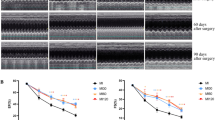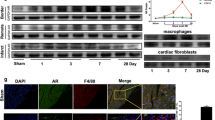Abstract
Over-expression of c-fos may play a role in some diseases. Research pertaining to the expression of c-fos in acute myocardial ınfarction (AMI) is rare, and the detailed role of c-fos in AMI has not been reported. Therefore, the purpose of this project was to elucidate the detailed effect of c-fos on AMI rats and evaluate the effect of a metoprolol intervention. An AMI rat model was established for the purposes of this study. The expression of c-fos in AMI was evaluated via immunohistochemical analysis and in situ hybridization. Simultaneously, we investigated the effect of c-fos on AMI rats via medicinal treatment with c-fos monoclonal antibody, isoproterenol, and metoprolol. Positive c-Fos protein expression and c-fos mRNA expression in cardiomyocytes were increased at 1, 3, 7, and 10 days after ligation in AMI rats compared with a sham-operated group. Peak expression occurred at 3 days after ligation. The weight percentage fraction of infarct size was decreased in rats treated with c-fos monoclonal antibody compared with the control normal saline treatment group. The weight percentage fraction of infarction size was increased after c-fos was increased via the administration of isoproterenol. c-Fos protein expression and the infarct size in rats treated with metoprolol were also decreased compared with the control normal saline treatment group. The results showed that c-fos expression rapidly increased after coronary ligation; c-fos plays an important role in myocardial lesions and is likely to be involved in the pathogenesis of AMI as well. Metoprolol can inhibit the expression of c-fos and has a positive therapeutic effect on rats after AMI; the involvement effect of metoprolol on myocardial infarction might be correlated with its effect on the inhibition of c-fos.




Similar content being viewed by others
References
Jin, S. P., Kim, J. H., Kim, M. A., et al. (2007). Prognostic significance of loss of c-Fos protein in gastric carcinoma. Pathology and Oncology Research, 13, 284–289.
Zhou, H., Gao, J., Lu, Z. Y., et al. (2007). Role of c-Fos/JunD in protecting stress-induced cell death. Cell Proliferation, 40, 431–444.
Zhang, S., He, B., Goldstein, S., et al. (2011). Changes in adiponectin expression in acute myocardial infarction rats and the significance of bisoprolol intervention. Canadian Journal of Physiology and Pharmacology, 89, 109–115.
Dalla Libera, L., Ravara, B., Gobbo, V., et al. (2005). Skeletal muscle myofibrillar protein oxidation in heart failure and the protective effect of Carvedilol. Journal of Molecular and Cellular Cardiology, 38, 803–807.
Watanabe, K., Ohta, Y., Inoue, M., et al. (2001). Bisoprolol improves survival in rats with heart failure. Journal of Cardiovascular Pharmacology, 38(Suppl 1), S55–S58.
Zhang, S., He, B., Goldstein, S., et al. (2010). The expression and significance of proto-oncogene c-fos in viral myocarditis. Virology Journal, 7, 285.
Verma, I. M., & Sassone-Corsi, P. (1987). Proto-oncogene fos: Complex but versatile regulation. Cell, 51, 513–514.
Miller, A. D., Curran, T., & Verma, I. M. (1984). c-Fos protein can induce cellular transformation: A novel mechanism of activation of a cellular oncogene. Cell, 36, 51–60.
Barker, P. E., Rabin, M., Watson, M., et al. (1984). Human c-fos oncogene mapped within chromosomal region 14q21—q31. Proceedings of the Natural Academy of Sciences USA, 81, 5826–5830.
Sng, J. C., Taniura, H., & Yoneda, Y. (2004). A tale of early response genes. Biological and Pharmaceutical Bulletin, 27, 606–612.
Herdegen, T., & Waetzig, V. (2001). AP-1 proteins in the adult brain: facts and fiction about effectors of neuroprotection and neurodegeneration. Oncogene, 20, 2424–2437.
Chiu, R., Boyle, W. J., Meek, J., et al. (1988). The c-Fos protein interacts with c-Jun/AP-1 to stimulate transcription of AP-1 responsive genes. Cell, 54, 541–552.
Patel, K. P., Zhang, K., Kenney, M. J., et al. (2000). Neuronal expression of Fos protein in the hypothalamus of rats with heart failure. Brain Research, 865, 27–34.
Itoh, H., Yagi, M., Fushida, S., et al. (2000). Activation of immediate early gene, c-fos, and c-jun in the rat small intestine after ischemia/reperfusion. Transplantation, 69, 598–604.
Sakai, H., Urasawa, K., Oyama, N., et al. (2007). Induction of c-fos mRNA expression by pure pressure overload in cultured cardiac myocytes. International Heart Journal, 48, 359–367.
Schneider, H. J., Rossner, S., Pfeiffer, D., et al. (2008). d-ribose improves cardiac contractility and hemodynamics, and reduces expression of c-fos in the hippocampus during sustained slow ventricular tachycardia in rats. International Journal of Cardiology, 125, 49–56.
Lavezzi, A. M., Milei, J., Grana, D. R., et al. (2003). Expression of c-fos, p53 and PCNA in the unstable atherosclerotic carotid plaque. International Journal of Cardiology, 92, 59–63.
Nelson, D. P., Wechsler, S. B., Miura, T., et al. (2002). Myocardial immediate early gene activation after cardiopulmonary bypass with cardiac ischemia-reperfusion. Annals of Thoracic Surgery, 73, 156–162.
Gidh-Jain, M., Huang, B., Jain, P., et al. (1998). Alterations in cardiac gene expression during ventricular remodeling following experimental myocardial infarction. Journal of Molecular and Cellular Cardiology, 30, 627–637.
Larsen, T. H., Skar, R., Frotjold, E. K., et al. (1998). Regional activation of the immediate-early response gene c-fos in infarcted rat hearts. International Journal of Experimental Pathology, 79, 163–172.
Ueyama, T., Sakoda, T., Kawashima, S., et al. (1997). Activated RhoA stimulates c-fos gene expression in myocardial cells. Circulation Research, 81, 672–678.
Barka, T., van der Noen, H., & Shaw, P. A. (1987). Proto-oncogene fos (c-fos) expression in the heart. Oncogene, 1, 439–443.
Takeshita, A., Shinoda, H., Nakabayashi, Y., et al. (2005). Sphingosine 1-phosphate acts as a signal molecule in ceramide signal transduction of TNF-alpha-induced activator protein-1 in osteoblastic cell line MC3T3-E1 cells. Journal of Oral Science, 47, 43–51.
Emch, G. S., Hermann, G. E., & Rogers, R. C. (2001). TNF-alpha-induced c-Fos generation in the nucleus of the solitary tract is blocked by NBQX and MK-801. American Journal of Physiology: Regulatory, Integrative and Comparative Physiology, 281, R1394–R1400.
Haliday, E. M., Ramesha, C. S., & Ringold, G. (1991). TNF induces c-fos via a novel pathway requiring conversion of arachidonic acid to a lipoxygenase metabolite. EMBO Journal, 10, 109–115.
Ono, H., Ichiki, T., Fukuyama, K., et al. (2004). cAMP-response element-binding protein mediates tumor necrosis factor-alpha-induced vascular smooth muscle cell migration. Arteriosclerosis, Thrombosis, and Vascular Biology, 24, 1634–1639.
Lurje, L., Wennerblom, B., Tygesen, H., et al. (1997). Heart rate variability after acute myocardial infarction in patients treated with atenolol and metoprolol. International Journal of Cardiology, 60, 157–164.
Ibanez, B., Cimmino, G., Prat-Gonzalez, S., et al. (2011). The cardioprotection granted by metoprolol is restricted to its administration prior to coronary reperfusion. International Journal of Cardiology, 147, 428–432.
Herlitz, J., Hjalmarson, A., Swedberg, K., et al. (1984). Relationship between infarct size and incidence of severe ventricular arrhythmias in a double-blind trial with metoprolol in acute myocardial infarction. International Journal of Cardiology, 6, 47–60.
Yan, S. H., Hu, H. S., Wang, X. L., et al. (2007). Effects of prolonged metoprolol treatment on neural remodeling and inducible ventricular arrhythmias after myocardial infarction in rabbits. International Journal of Cardiology, 117, 317–322.
Author information
Authors and Affiliations
Corresponding author
Rights and permissions
About this article
Cite this article
Zhang, S., Zhang, M., Goldstein, S. et al. The Effect of c-fos on Acute Myocardial Infarction and the Significance of Metoprolol Intervention in a Rat Model. Cell Biochem Biophys 65, 249–255 (2013). https://doi.org/10.1007/s12013-012-9428-0
Published:
Issue Date:
DOI: https://doi.org/10.1007/s12013-012-9428-0




